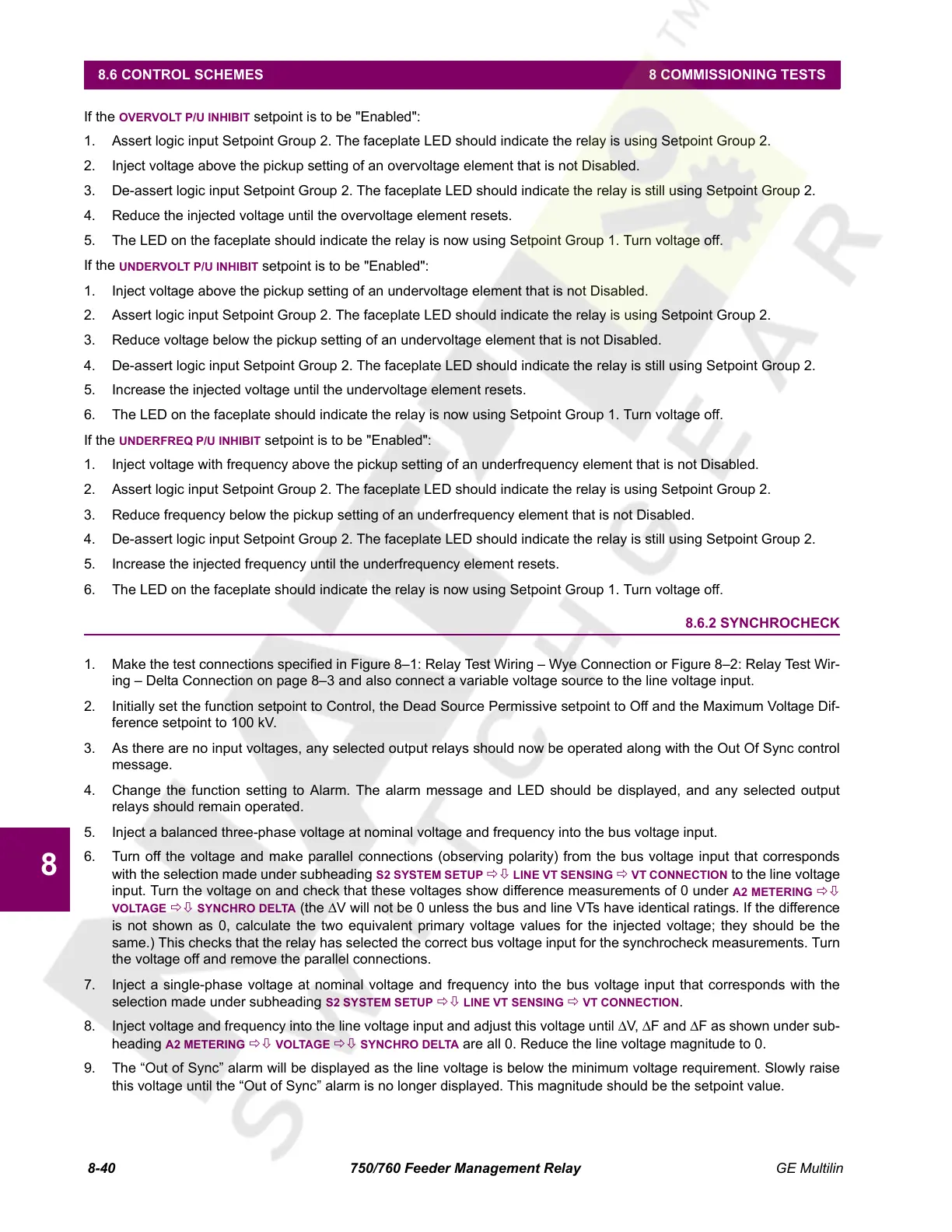8-40 750/760 Feeder Management Relay GE Multilin
8.6 CONTROL SCHEMES 8 COMMISSIONING TESTS
8
If the OVERVOLT P/U INHIBIT setpoint is to be "Enabled":
1. Assert logic input Setpoint Group 2. The faceplate LED should indicate the relay is using Setpoint Group 2.
2. Inject voltage above the pickup setting of an overvoltage element that is not Disabled.
3. De-assert logic input Setpoint Group 2. The faceplate LED should indicate the relay is still using Setpoint Group 2.
4. Reduce the injected voltage until the overvoltage element resets.
5. The LED on the faceplate should indicate the relay is now using Setpoint Group 1. Turn voltage off.
If the
UNDERVOLT P/U INHIBIT setpoint is to be "Enabled":
1. Inject voltage above the pickup setting of an undervoltage element that is not Disabled.
2. Assert logic input Setpoint Group 2. The faceplate LED should indicate the relay is using Setpoint Group 2.
3. Reduce voltage below the pickup setting of an undervoltage element that is not Disabled.
4. De-assert logic input Setpoint Group 2. The faceplate LED should indicate the relay is still using Setpoint Group 2.
5. Increase the injected voltage until the undervoltage element resets.
6. The LED on the faceplate should indicate the relay is now using Setpoint Group 1. Turn voltage off.
If the
UNDERFREQ P/U INHIBIT setpoint is to be "Enabled":
1. Inject voltage with frequency above the pickup setting of an underfrequency element that is not Disabled.
2. Assert logic input Setpoint Group 2. The faceplate LED should indicate the relay is using Setpoint Group 2.
3. Reduce frequency below the pickup setting of an underfrequency element that is not Disabled.
4. De-assert logic input Setpoint Group 2. The faceplate LED should indicate the relay is still using Setpoint Group 2.
5. Increase the injected frequency until the underfrequency element resets.
6. The LED on the faceplate should indicate the relay is now using Setpoint Group 1. Turn voltage off.
8.6.2 SYNCHROCHECK
1. Make the test connections specified in Figure 8–1: Relay Test Wiring – Wye Connection or Figure 8–2: Relay Test Wir-
ing – Delta Connection on page 8–3 and also connect a variable voltage source to the line voltage input.
2. Initially set the function setpoint to Control, the Dead Source Permissive setpoint to Off and the Maximum Voltage Dif-
ference setpoint to 100 kV.
3. As there are no input voltages, any selected output relays should now be operated along with the Out Of Sync control
message.
4. Change the function setting to Alarm. The alarm message and LED should be displayed, and any selected output
relays should remain operated.
5. Inject a balanced three-phase voltage at nominal voltage and frequency into the bus voltage input.
6. Turn off the voltage and make parallel connections (observing polarity) from the bus voltage input that corresponds
with the selection made under subheading
S2 SYSTEM SETUP ÖØ LINE VT SENSING Ö VT CONNECTION to the line voltage
input. Turn the voltage on and check that these voltages show difference measurements of 0 under
A2 METERING ÖØ
VOLTAGE ÖØ SYNCHRO DELTA (the ΔV will not be 0 unless the bus and line VTs have identical ratings. If the difference
is not shown as 0, calculate the two equivalent primary voltage values for the injected voltage; they should be the
same.) This checks that the relay has selected the correct bus voltage input for the synchrocheck measurements. Turn
the voltage off and remove the parallel connections.
7. Inject a single-phase voltage at nominal voltage and frequency into the bus voltage input that corresponds with the
selection made under subheading
S2 SYSTEM SETUP ÖØ LINE VT SENSING Ö VT CONNECTION.
8. Inject voltage and frequency into the line voltage input and adjust this voltage until ΔV, ΔF and ΔF as shown under sub-
heading A2 METERING ÖØ VOLTAGE ÖØ SYNCHRO DELTA are all 0. Reduce the line voltage magnitude to 0.
9. The “Out of Sync” alarm will be displayed as the line voltage is below the minimum voltage requirement. Slowly raise
this voltage until the “Out of Sync” alarm is no longer displayed. This magnitude should be the setpoint value.
Courtesy of NationalSwitchgear.com

